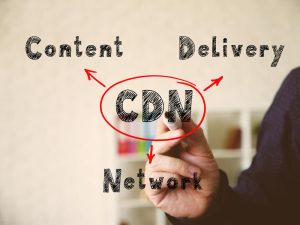A Content Delivery Network (CDN) is a system of distributed servers that deliver web content to a user based on their geographic location. CDNs can be used to improve the performance of web applications by providing faster content delivery, reducing latency, and offloading the origin server. This post will discuss the benefits of using a CDN and how it can help speed up a website.

What is a CDN?
A Content Delivery Network (CDN) is a distributed network of servers located around the globe. The servers are connected to each other, allowing content to be delivered faster to users based on their geographic location. CDNs are used to improve the performance of web applications by reducing latency, offloading the origin server, and providing faster content delivery. How does a CDN help speed up a website? The primary benefit of using a CDN is that it can significantly reduce latency. By distributing content over a wide range of servers, content is delivered to the user faster. Additionally, CDNs can help offload the origin server, freeing up resources for other tasks. This helps reduce server load and improves response times.
CDNs can also improve the overall user experience by providing faster content delivery. By caching static content, such as images and videos, CDNs can reduce the number of requests to the origin server and decrease the time it takes for content to be delivered. Finally, CDNs can help improve the scalability of web applications. By using a distributed network of servers, CDNs are able to handle large amounts of traffic without affecting performance. This makes it easier to scale applications as needed without experiencing performance issues. In conclusion, CDNs are an effective way to improve the performance of web applications. By reducing latency, offloading the origin server, providing faster content delivery, and improving scalability, CDNs can significantly improve the user experience and help speed up a website.
As a result of improving the loading speed of the website pages, this will also affect SEO efforts and improve the visibility of the website pages in search engines, primarily Google.
Benefits of using a CDN
A Content Delivery Network (CDN) is a powerful tool for improving the speed and performance of a website. With a CDN, web content is delivered from servers located in multiple geographic locations, allowing for faster delivery to users based on their location. By leveraging this distributed network of servers, a CDN can help reduce latency and offload the origin server, resulting in an overall faster website. In addition to faster delivery speeds, a CDN also helps to reduce bandwidth costs. Instead of sending content from a single source, a CDN replicates content across multiple servers. This reduces the amount of traffic that needs to be sent from the origin server, resulting in lower bandwidth costs. A CDN also helps to improve website security. By caching content across multiple servers, a CDN helps to protect against Denial of Service (DoS) attacks, which can greatly reduce the risk of a website becoming unavailable due to malicious traffic.
Finally, a CDN can also help to improve the scalability of a website. By distributing content across multiple servers, a CDN helps to ensure that a website can handle increased traffic without any performance issues. This is especially useful for websites that experience high levels of traffic during peak periods. In conclusion, using a CDN can provide a number of benefits to a website. By leveraging a distributed network of servers, a CDN can help reduce latency, offload the origin server, reduce bandwidth costs, improve security, and improve scalability. All of these benefits can help to improve the performance and speed of a website, making it a powerful tool for any website owner.
How Does a CDN Work?
A Content Delivery Network (CDN) is a system of distributed servers that deliver web content to a user based on their geographic location. The CDN stores static content such as images, videos, and web pages on its servers located around the world. When a user requests web content, the CDN automatically checks the user’s location and delivers the content from the closest server. This makes it possible to deliver content faster and with reduced latency. CDNs can also be used to offload traffic from the origin server. By caching content on its servers, the CDN can reduce the load on the origin server. This helps to ensure that the origin server is not overloaded by requests and can respond to requests quickly. In addition, CDNs can also be used to improve security by protecting against DDoS attacks. By distributing traffic across multiple servers, a CDN can make it more difficult for attackers to overwhelm the origin server with requests. Overall, CDNs can be used to improve the performance of web applications. By providing faster content delivery, reducing latency, offloading the origin server, and protecting against DDoS attacks, CDNs can help speed up a website. This makes it an invaluable tool for ensuring the best possible user experience.
Implementing a CDN
Implementing a CDN is a simple and effective way to increase the speed and performance of a website. A CDN is a network of servers that are strategically located around the world. With a CDN, the content of a website is distributed to each of these servers and is then served to users based on their geographic location. This helps to reduce latency and improve loading times of the website. By implementing a CDN, content is delivered to the user faster, resulting in a better user experience. CDNs also help to offload the origin server. By distributing content across multiple servers, it takes some of the load off the origin server and reduces the number of requests that it needs to handle. This can help to improve the overall performance and reliability of the website. Another benefit of using a CDN is that it can help protect against malicious attacks. Since the content is distributed across multiple servers, it helps to provide a layer of protection against DDoS attacks, which can cause major disruptions to websites. Overall, a CDN can be a great way to improve the performance and reliability of a website. By reducing latency, offloading the origin server, and providing additional protection against malicious attacks, a CDN can help improve the user experience and ensure that the website is running at optimal speeds.
Conclusion
Using a CDN is an important step to ensuring the performance of a website. The advantages of a CDN are numerous: faster content delivery, improved performance and reliability, offloading of origin server requests, and reduced latency. In addition, CDNs can also improve the user experience by providing content quickly and efficiently. Ultimately, CDNs can help websites to achieve higher levels of performance and reliability, while also providing a better user experience. As technology continues to evolve, CDNs will become an even more integral part of any website’s performance optimization strategy.
Benefits of using a CDN:
| Benefit | Advantage | Impact | Outcome |
| Faster Content Delivery | Reduced Latency | Offloads the Origin Server | Improved Web Application Performance |
| Higher Availability | Caching Content Closer to Users | Reduced Bandwidth Usage | More Reliable Website |
| Load Balancing | Distributed Servers | Increased Capacity | Enhanced User Experience |
| Increased Security | Protection from DDoS Attacks | Reduced Risk of Unauthorized Access | Secure Website |
Using a CDN can have significant performance benefits for a website, allowing it to reach a wider audience faster and with fewer resources. Implementing a CDN is a simple and cost-effective way to improve the performance of a website.

